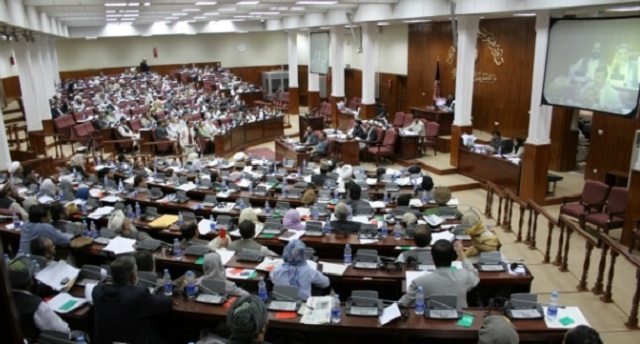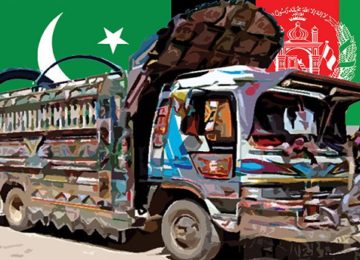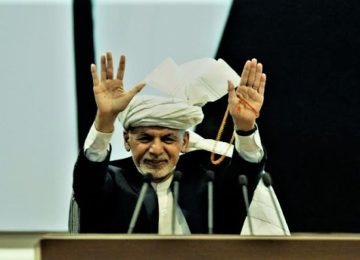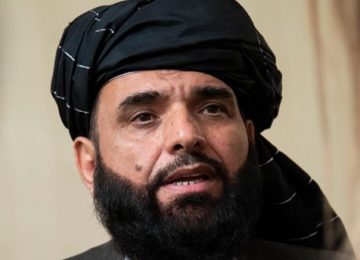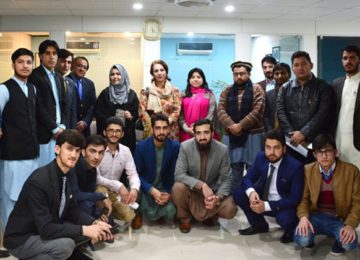Afghanistan’s Independent Electoral Commission (IEC) has posted a clock on its home page that counts down the time remaining until the 20 October parliamentary election (minus Ghazni province). That’s a nice gag. It also would have been good if a counter had been provided to show, for example, the total number of registered voters (on its Dari page) or the total number of candidates. In both cases, readers need to add the figures themselves. These examples are only a few showing how the IEC does not make it easy to follow the electoral process. Therefore, AAN co-director Thomas Ruttig, with input from the AAN team, has compiled some basic facts about the Afghan elections. AAN has put together a dossier of dispatches related to the coming elections, looking at preparations and political manoeuvring. Each dispatch in the Election Conundrum series will be added to it.
Afghanistan’s next parliamentary elections will be held on Saturday, 20 October 2018. The election campaign started on 28 September. There will be a 48 hour silence period on 18 and 19 October immediately before election day.
Preliminary results are scheduled for the 10 November and the final results to be made known on 20 December 2018.
The 2018 elections are the third parliamentary elections in post-Taleban Afghanistan. According to the official count (each legislative period has its number), this is the 17th in the country’s history. It is not clear which election was counted as the first. [Amended: According to Daud Junbesh writing on the BBC’s Pashto service on 9 October 2018, the first parliament under the currently used name Shura-ye Melli was established under King Muhammad Nader Shah (ruled 1929-33) with 111 members. (1)] However, it is clear that the first relatively free vote was held in 1949 that established the seventh parliament. Women voted for the first time in 1965 for the tenth parliament.
This year’s polls are three and a half years behind schedule.
The elections will take place in 33 out of the country’s 34 provinces. The exception is Ghazni (for AAN background see here and here). The kuchis (nomads) constitute another countrywide constituency.
Voters and candidates
According to the latest information provided on the English part of the website of the Independent Electoral Commission (IEC), 8,918,107 people have been registered as voters. This includes 3,067,918 women, 5,681,592 men, 168,015 kuchis and 583 Sikhs and Hindus (the latter are not differentiated into men and women, and all figures still include Ghazni province; see IEC’s Dari website). On 1 October, the IEC published – on Facebook and in Dari and Pashto only – an approximate figure of 8.8 million voters, without Ghazni. It also said that over 600,000 registrations had been cancelled because they were either underage people or had missing dates of birth, or were duplicate entries.The IEC has not explained to the public how they arrived at the latest figures, ie how it verified voter registration figures. (Find the number of voters per polling centre in each province in Dari on the IEC website, here)
There are 250 seats at stake in the lower house, the Wolesi Jirga. Ten seats are reserved for kuchis and one jointly for the two small Sikh and Hindu communities. This seat had been added by the latest change of the electoral law in late 2016 (AAN reporting here).
The exact number of candidates is unclear. Countrywide, AAN counted 2,532 candidateson the ballot papers from the provincial lists on the IEC website. (2)
The IEC, in contrast, has provided different figures. On 4 September, IEC deputy spokesperson, Kobra Rezayi, told AAN there were 2,651 candidates in total, comprising 2,250 men, 401 women and 49 kuchi; the IEC has only figures per province on its website but no total. Media have been given other figures again. For example, The New York Times has published a figure of 2,565 candidates, among them 417 women, based on IEC information from early October. The difference may be the result of the reinstatement of candidates who earlier had been ruled out ineligible.
Overall, these numbers are similar to the 2010 parliamentary elections, when there were 2,584 candidates, including 406 women, who ran for office. This year, 35 candidates have been excluded by the IEC, mainly for their links to illegal armed groups (more detail here).
Since then, three candidates have been killed (see below). One female candidate, Fariba Rahmani, from Badghis, died in a traffic accident and another one in Kabul, Shah Gul Rezayi, withdrew. They and the candidates recently killed are still on the ballot papers.
The capital Kabul has 804 candidates, among them 119 women. Many of these candidates come from the provinces. They include a number of members of the 2010 parliament who had been elected in other provinces but do not feel safe enough to campaign outside the capital this time. Others apparently think that winning a seat in Kabul would be easier, as the multitude of aspirants would split the vote, meaning a lower number of votes would suffice to win a seat there.
Voting system
The voting system is based on 35 multi-seat constituencies (the 34 provinces and the nomads) which are identical with the provinces. The number of seats allocated to each constituency depends on the size of population. This leads to a range from 33 seats for Kabul province (which includes the city and 14 rural districts) to Nimruz or Panjshir with two.
Kuchi representatives have criticised the IEC’s policy that all votes should cast their votes in the area where they have registered. They said this may prevent many of them from participating in the elections, as they had registered near their summer pastures, but now had moved to their winter quarters.
68 (about one fourth) of the 250 seats are reserved for women. This is again based on the population size. Kabul, for example, has the most, with nine. This does not mean that only women vote for women, and men for men. There are joint male/female candidate lists for each constituency. In both ‘segments’ (male and female), those with the most votes win a seat. For example, in Kabul, this means the 24 men and nine women with the most votes. If in any province more women than foreseen by the quota win a sufficient number of votes, all of them go into the Wolesi Jirga, thus decreasing the part of the men. (This happened in Nimruz province in the 2010 elections, where women won both provincial seats and again, in several cases, in the 2005 election.)
There is only one candidate for the Sikh/Hindu seat, Narinder Singh Khalsa (media report here). He replaced his father, Avtar Singh Khalsa, who was originally running, but was killed by a suicide bomber in Jalalabad in early July (media report here). The IEC registered 1,105 Sikh and Hindu voters, 759 in Kabul, 342 in Nangarhar and 4 in Helmand (see here, here and here).
Role of political parties
A total of 205 candidates – eight per cent – countrywide have registered as members of political parties. The remainder are registered as ‘independents.’ According to an AAN count, Vice President Abdul Rashid Dostum’s party, Jombesh-e Melli-ye Islami, has the most candidates, with 44, including eight women; followed by Gulbuddin Hekmatyar’s Hezb-e Islami with 42 (two women) and deputy Chief Executive, Haji Muhammad Mohaqqeq’s Hezb-e Wahdat-e Islami-ye Mardom, with 22 (five women). (3)
Political parties are legal in Afghanistan. The law allows them to compete, but only as individuals who can register themselves under their party’s name. However, parties cannot field lists of candidates. Although the establishment of party-based factions in parliament is not formally banned, it has been discouraged from 2005 onwards, for example, by former president Hamed Karzai, and, in practice, has never happened. However, amongst the ‘independent’ candidates, many are known to belong to political parties.
Polling centres and observers
Countrywide, there were supposed to be 7,366 polling centres open on election day. Each one has at least two polling stations with separate facilities for men and for women, leading to 21,000 in total. Only around 5,100 – about two thirds – of these polling centres are scheduled to open on election day for security reasons, according to the Afghan Ministry of the Interior, confirmed in a UN report.
The elections will be observed by domestic and international observers, candidates’ and political parties’ agents, as well as the media. While final figures are not available yet, the number of international observers will be lower than ever witnessed since 2001. The EU only is sending a three-member team, and there seems to be no OSCE presence, in stark contrast to earlier elections. The UN will have some 400 observers, and it can be assumed that most will be Afghans.
Five major domestic election observer organisations said in a statement distributed on 6 October, that they will deploy a total of 6,565 observers (40 per cent are women) “throughout the country to cover as many polling centers and polling stations as possible.” This will comprise: 2,500 by the Transparent Elections Foundation of Afghanistan Organization (TEFA); 1,130 by Election and Transparency Watch Organization of Afghanistan (ETWOA); 1,117 by Afghan Civil Society Forum Organization (ACSFO); 1,100 by Free and Fair Election of Afghanistan Organization (FFAEO) and 818 by the Afghan Amputee Bicyclists for Rehabilitation and Recreation (AABRAR).
The Taleban and pre-election violence
In April 2018, the Taleban announced their opposition (media report here) to the elections and called for a boycott. AAN understands there were attempts through various channels to at least persuade them not to actively interrupt the elections. This seems to have led to nothing, as the Taleban published another statement on 8 October 2018 repeating their boycott calland urged candidates to withdraw their participation, as the elections were only “bogus” and were “conducted for the sole purpose of legitimizing those stooges who are authorized by the occupying forces” and “of minimizing the [people’s] resentment against the foreign occupation.” They instructed “its Mujahidin to halt this American led process throughout the country by creating severe obstacles for it, while taking extensive and intensive care of civilian Afghan lives and their properties. (…) No stone should be left unturned for the prevention and failure of this malicious American conspiracy.” It declared “those people who are trying to help in holding this process successfully by providing security” (our emphasis) targets.
The UN reported that in the first month of voter registration after mid-April 2018, some 86 civilians were killed and 185 injured. According to the IEC, five candidates had been killed before the election campaign started in late September. Since then, a further four candidates have been killed, in Parwan, Ghazni, Kandahar and, on the day of publication, in Helmand; a fifth one wounded in Kabul and convoys of three more have been attacked in Kunar and, in two incidents, in Khost. In Kunar, three bodyguards were killed and in Khost five people were injured (see here and here). In early October, a suicide attack, claimed by the local franchise of the Islamic State in Kama district, Nangrahar, killed at least 13 people and wounded more than 30 (media report here). The 9 October attack was a suicide attack in the office of the a candidate that killed at least nine more people and injuring others.
The Ministry of Interior reported they have assigned 54,776 members of the Afghan National Security Forces (ANSF) for the security of 5,100 polling centres for the five days ahead of the elections, and will hold an additional 9,540 forces in the reserve.
Next elections
Further, presidential and provincial council elections are scheduled for 20 April 2019. The IEC has announced on 1 October that the postponed Ghazni parliamentary elections will be held on the same day. It is not clear yet whether this will also be the case with the district council elections that had originally been scheduled for 20 October and been postponed.
The counting and adjudication process for the parliamentary elections is expected to continue until 20 December 2018, and the candidate registration for the 2019 presidential election is scheduled for 11 to 25 November 2018 (their preliminary list to be published on 10 December and the final list on 16 January 2019). There is the danger that problems and possibly further delays in the former might overspill and influence the latter. (See the electoral calendar for the 20 October parliamentary elections in Footnote 4.)
With regard to local and international election observation and the use of biometrical equipment, for calculation of the voter turnout and to prevent electoral fraud, AAN will soon publish separate, more detailed dispatches.
(1) According to an article by Hafizullah Emadi in the German Internationales Asienforum (2008) unter the title “Establishment of Afghanistan’s Parliament and the Role of Women Parliamentarians: Retrospect and Prospects”, this parliament was established and its lower house “elected” but there is no further information about the procedure, participation or results.
(2) The IEC has published the following final provincial lists of candidates:
Kabul: 804 candidates (http://www.iec.org.af/pdf/candidates-list-1397/final/kabul.pdf);
Bamyan: 40 candidates (http://www.iec.org.af/pdf/candidates-list-1397/final/bamyan.pdf);
Nuristan: 18 candidates (http://www.iec.org.af/pdf/candidates-list-1397/final/nooristan.pdf);
Kunar: 31 candidates (http://www.iec.org.af/pdf/candidates-list-1397/final/kunarha.pdf)
Khost: 55 candidates (http://www.iec.org.af/pdf/candidates-list-1397/final/khost.pdf)
Urozgan: 25 candidates (http://www.iec.org.af/pdf/candidates-list-1397/final/uruzgan.pdf)
Nimruz: 12 candidates (http://www.iec.org.af/pdf/candidates-list-1397/final/nimroz.pdf)
Balkh: 85 candidates (http://www.iec.org.af/pdf/candidates-list-1397/final/balkh.pdf)
Daikundi: 41 candidates (http://www.iec.org.af/pdf/candidates-list-1397/final/daykundi.pdf)
Herat: 161 candidates (http://www.iec.org.af/pdf/candidates-list-1397/final/herat.pdf)
Kapisa: 35 candidates (http://www.iec.org.af/pdf/candidates-list-1397/final/kapisa.pdf)
Paktika: 33 candidates (http://www.iec.org.af/pdf/candidates-list-1397/final/paktika.pdf)
Panjshir: 12 candidates (http://www.iec.org.af/pdf/candidates-list-1397/final/panjshir.pdf)
Parwan: 28 candidates (http://www.iec.org.af/pdf/candidates-list-1397/final/parwan.pdf)
Wardak: 40 candidates (http://www.iec.org.af/pdf/candidates-list-1397/final/wardak.pdf)
Laghman: 33 candidates (http://www.iec.org.af/pdf/candidates-list-1397/final/laghman.pdf)
Sar-e Pul: 33 candidates (http://www.iec.org.af/pdf/candidates-list-1397/final/sarepul.pdf)
Badakhshan: 76 candidates (http://www.iec.org.af/pdf/candidates-list-1397/final/badakhshan.pdf)
Jawzjan: 30 candidates (http://www.iec.org.af/pdf/candidates-list-1397/final/jawzjan.pdf)
Faryab: 62 candidates (http://www.iec.org.af/pdf/candidates-list-1397/final/faryab.pdf)
Samangan: 31 candidates (http://www.iec.org.af/pdf/candidates-list-1397/final/samangan.pdf)
Zabul: 24 candidates (http://www.iec.org.af/pdf/candidates-list-1397/final/zabul.pdf)
44 Kuchi candidates (http://www.iec.org.af/pdf/candidates-list-1397/final/kuchi.pdf); one Sikh candidate (http://www.iec.org.af/pdf/candidates-list-1397/final/sikh.pdf)
Kandahar: 112 candidates (http://www.iec.org.af/pdf/candidates-list-1397/final/kandahar.pdf)
Helmand: 92 candidates (http://www.iec.org.af/pdf/candidates-list-1397/final/helmand.pdf)
Kunduz: 90 candidates (http://www.iec.org.af/pdf/candidates-list-1397/final/kunduz.pdf)
Nanhargar: 137 candidates (http://www.iec.org.af/pdf/candidates-list-1397/final/nangarhar.pdf)
Badghis: 35 candidates (http://www.iec.org.af/pdf/candidates-list-1397/final/badghis.pdf)
Logar: 35 candidates (http://www.iec.org.af/pdf/candidates-list-1397/final/logar.pdf)
Baghlan: 88 candidates (http://www.iec.org.af/pdf/candidates-list-1397/final/baghlan.pdf)
Paktia: 78 candidates (http://www.iec.org.af/pdf/candidates-list-1397/final/paktia.pdf)
Takhar: 73 candidates (http://www.iec.org.af/pdf/candidates-list-1397/final/takhar.pdf)
Ghor: 30 candidates (http://www.iec.org.af/pdf/candidates-list-1397/final/ghor.pdf)
Farah: 42 candidates (http://www.iec.org.af/pdf/candidates-list-1397/final/farah.pdf)
(3) Here a list of the 26 political parties that have nominated a total of 205 candidates under their name and their numbers, compiled by AAN. Some of these candidates have been ruled ineligible but most later reinstated – so that an exact final number cannot provided, here, too (source: UNAMA):
- Hezb-e Jombesh-e Melli Islami Afghanistan (National Islamic Movement of Afghanistan Party): 44 –– 35 men (Kabul, Nangarhar, Baghlan, Bamian, Badakhshan, Takhar, Kunduz, Samangan, Balkh, Sar-e Pul, Jawzjan, Badghis, Herat, Farah, Faryab); 9 women (Kabul, Badakhshan, Takhar, Kunduz, Balkh, Jawzjan, Faryab)
- Hezb-e Islami Afghanistan (Islamic Party of Afghanistan): 42 –– 37 men (Kabul; Kapisa, Parwan, Maidan-Wardak, Kandahar, Nangarhar, Laghman, Baghlan, Paktia, Khost, Kunar, Badakhshan, Takhar, Kunduz, Sar e Pul, Ghor, Zabul, Faryab, Badghis, Herat); 3 women (Maidan-Wardak, Nangarhar, Kunduz); 2 Kuchi
- Hezb-e Wahdat-e Islami-ye Mardom Afghanistan (Islamic Unity Party of the People of Afghanistan): 22 –– 16 men (Kabul, Bamian, Kunduz, Samangan, Balkh, Sar e Pul, Ghor, Herat, Daikundi); 5 women (Wardak, Samangan, Balkh, Sar e Pul, Daikundi); 1 Kuchi
- Hezb-e Wahdat-e Islami Afghanistan (Islamic Unity Party of Afghanistan): 17 ––16 men (Kabul, Wardak, Baghlan, Bamian, Samangan, Balkh, Sar-e Pul, Ghor, Daikundi, Herat); 1 woman (Kabul)
- De Afghanistan de Melli Wahdat Wolesi Tahrik Gond (National Unity Popular Movement Party of Afghanistan): 13 –– 11 men (Kabul, Nangarhar, Kunduz, Uruzgan, Kandahar, Herat); 2 women (Kabul, Uruzgan)
- Hezb-e Mutahed-e Melli Afghanistan (Afghanistan National United Party): 8 –– 6 men (Kabul, Kunduz); 2 women (Kandahar, Kabul)
- Hezb-e Jamiat e Islami (Islamic Society Party): 8 –– 7 men (Baghlan, Takhar, Faryab, Balkh); 1 woman (Balkh)
- Hezb-e Mahaz-e Melli-ye Islami Afghanistan (National Islamic Front Party of Afghanistan): 7 –– 5 men (Kunduz, Balkh, Kabul, Herat), 2 women (Kunduz, Balkh)
- Hezb-e Insaf-e Melli-ye Islami Afghanistan (Afghanistan Islamic Fairness Party): 4 –– 2 women (Kabul, Bamian); 2 men (Kunduz, Daikundi)
- Hezb-e Herasat-e Islami Afghanistan (Afghanistan Islamic Protection Party): 4 –– 4 men (Kabul, Sar-e Pul, Herat, Bamian)
- Hezb-e Dawat-e Islami Afghanistan (Islamic Mission Party of Afghanistan): 4 –– 4 men (Kabul, Wardak, Nangrahar)
- Rawand-e Hefazat az Arzeshha-ye Jehad wa Muqawamat (Movement for the Protection of the Values of Jehad and Resistance): 3 –- 3 men (Nangrahar, Kabul, Wardak)
- Hezb-e Afghan Mellat (Afghan Nation Party): 2 –– 2 men (Nangrahar, Herat)
- Hezb-e Harakat-e Inqelab-e Islami-ye Mardom-e Afghanistan (Afghanistan People’s Islamic Revolution Movement Party): 2 –– 2 men (Kabul, Nangrahar)
- Hezb-e Etedal Afghanistan (Afghanistan Equity Party): 2 –– 2 men (Herat, Kabul)
- Hezb-e Paiwand Milli (National Solidarity Party): 2 –– 2 men (Kabul)
- Hezb-e Eqtedar-e Islami Afghanistan (National Islamic Sovereignty Party): 2 –– 2 men (Kabul)
- De Afghanistan Wolesi Harakat Gund (Popular Movement Party of Afghanistan): 1 –– 1 man (Kandahar)
- De Afghanistan de Sole Melli Gund (Afghanistan National Peace Party): 1 –– 1 man (Balkh)
- Hezb-e Bedari-ye Mellat-e Afghanistan (Afghanistan Nation’s Awakening Party): 1 –- 1 man (Kabul)
- Hezb-e Harakat-e Islami Azad Afghanistan (Free Islamic Movement Party of Afghanistan): 1 –– 1 man (Balkh)
- Hezb-e Harakat-e Islami-ye Mellat-e Afghanistan (Afghanistan Nation’s Islamic Movement Party): 1 –– 1 man (Kabul)
- Hezb-e Musharekat-e Melli Afghanistan (Afghanistan National Participation Party): 1 –– 1 man (Kabul)
- Nohzat-e Melligerayi-ye Afghanistan (National Movement of Afghanistan): 1 –– 1 man (Kabul)
- Hezb-e Islami-ye Mutahed Afghanistan (United Islamic Party of Afghanistan): 1 –– 1 man (Kabul)
- Melli Bawar Gund (National Trust Party): 1 –– 1 man (Kabul)
(4) The electoral calendar for the 20 October parliamentary elections (see AAN dispatch here):
Based on the electoral law, the electoral calendar should be prepared and published by the IEC 120 days before election day. The IEC did publish this on time (see here and here), on 22 April 2018 (translated into English and added Gregorian dates by AAN, with important dates in bold):
| Number | Activity | Start date | End date | Gregorian dates |
| 1 | Announcement of Election Day | 11 Hamal | 11 Hamal | 31 March 2018 |
| 2 | Voter Registration | 25 Hamal | 22 Jawza | 14 April to 12 June |
| 3 | Filing of objections and complaints regarding voter registration and addressing them | 25 Hamal | 1 Saratan | 14 April to 22 June |
| 4 | Publishing the voter list | 23 Asad | 23 Asad | 14 August |
| 5 | Publishing the electoral calendar | 2 Saur | 2 Saur | 22 April |
| 6 | Registration of candidates for the Wolesi Jirga and district councils | 5 Jawza | 22 Jawza | 26 May to 12 June |
| 7 | Reviewing candidates’ registration information | 6 Jawza | 6 Saratan | 27 May to 27 June |
| 8 | Publishing the preliminary candidate list | 7 Saratan | 7 Saratan | 28 June |
| 9 | Filing challenges to the preliminary candidate list, as well as corrections | 7 Saratan | 9 Saratan | 28 to 30 June |
| 10 | Addressing challenges to the preliminary candidate list | 9 Saratan | 11 Asad | 30 June to 2 July |
| 11 | Final date for candidate withdrawal | 8 Saratan | 10 Asad | 29 June to 1 August |
| 12 | Publishing final list of candidates | 12 Asad | 12 Asad | 3 August |
| 13 | Finalising polling centre list in terms of security | 2 Saratan | 2 Saratan | 23 June |
| 14 | Establishing a Media Commission | 6 Saur | 28 Hut | 26 April 2018 to 19 March 2019 |
| 15 | Campaign period for the Wolesi Jirga election | 6 Mizan | 25 Mizan | 28 September to 17 October |
| 16 | Campaign period for district council election | 11 Mizan | 25 Mizan | 3 to 17 October |
| 17 | ‘Silence period’ (no campaigning) | 26 Mizan | 27 Mizan | 18 to 19 October |
| 18 | Filing complaints about the campaign period | 6 Mizan | 27 Mizan | 28 September to 19 October |
| 19 | Voting day | 28 Mizan | 28 Mizan | 20 October |
| 20 | Tabulation of the Wolesi Jirga | 28 Mizan | 19 Aqrab | |
| 21 | Filing complaints about voting and the count and addressing them | 28 Mizan | 29 Aqrab | 20 October to 20 November |
| 22 | Announcement of the preliminary results of the Wolesi Jirga elections | 19 Aqrab | 19 Aqrab | 10 November |
| 23 | Filing complaints about the preliminary results of the Wolesi Jirga elections | 20 Aqrab | 21 Aqrab | 11 to 12 November |
| 24 | Addressing complaints about the preliminary results of the Wolesi Jirga elections | 21 Aqrab | 14 Qaws | 12 November to 5 December |
| 25 | Sending the final decision(s) of the ECC to the IEC | 14 Qaws | 21 Qaws | 5 to 12 December |
| 26 | Announcing final results of the Wolesi Jirga elections | 29 Qaws | 29 Qaws | 20 December |
| 27 | Tabulation of votes of the district council elections | 20 Aqrab | 17 Qaws | 11 November to 8 December |
| 28 | Announcement of preliminary results of the district council elections | 18 Aqrab | 18 Aqrab | 9 November |
| 29 | Filing complaints about the preliminary results of the district council elections | 18 Qaws | 20 Qaws | 9 November to 11 December |
| 30 | Addressing complaints about the preliminary results of the district council elections | 20 Qaws | 22 Jaddi | 11 December 2018 to 12 January 2019 |
| 31 | Sending decision(s) of ECC to IEC | 23 Jaddi | 28 Jaddi | 13 to 18 January |
| 32 | Announcing final results of the district council elections | 4 Dalw | 4 Dalw | 24 January 2019 |
By Special Arrangement with AAN. Original link.
Disclaimer: Views expressed on this blog are not necessarily endorsed or supported by the Center for Research and Security Studies, Islamabad.



